人教版(2019)必修第二册Unit 4 History and Traditions Reading and Thinking课件(共31张ppt)
文档属性
| 名称 | 人教版(2019)必修第二册Unit 4 History and Traditions Reading and Thinking课件(共31张ppt) | 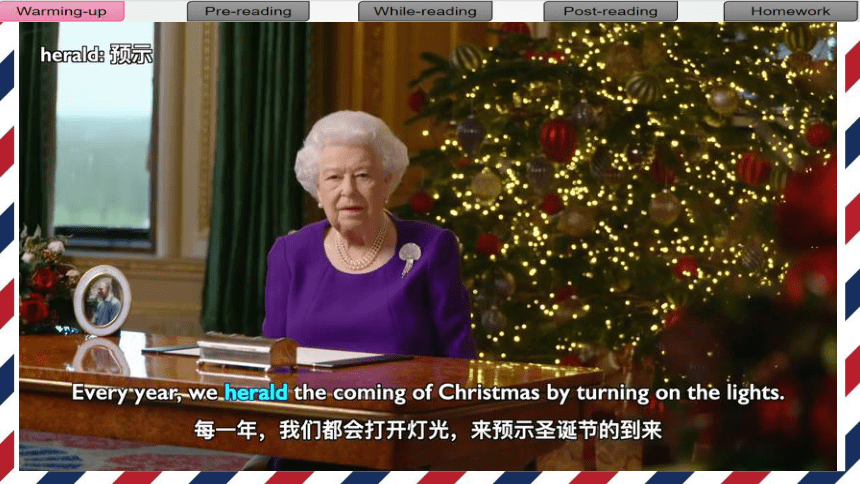 | |
| 格式 | pptx | ||
| 文件大小 | 28.9MB | ||
| 资源类型 | 教案 | ||
| 版本资源 | 人教版(2019) | ||
| 科目 | 英语 | ||
| 更新时间 | 2024-04-19 19:52:10 | ||
图片预览

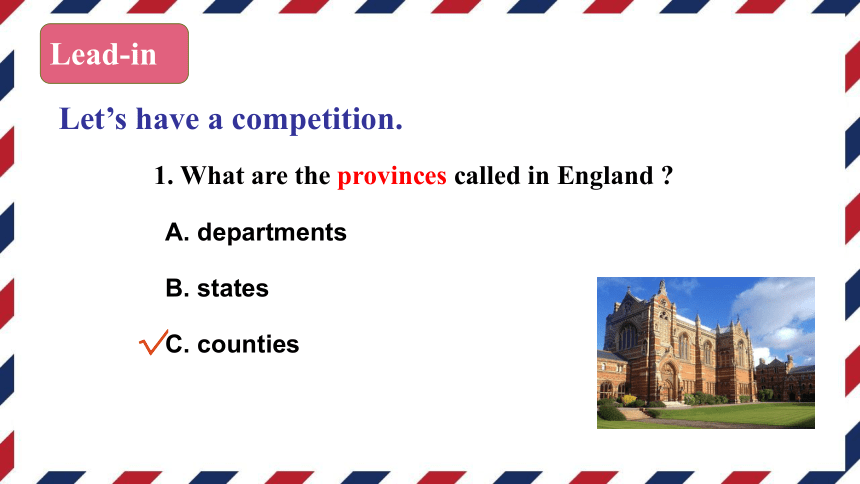
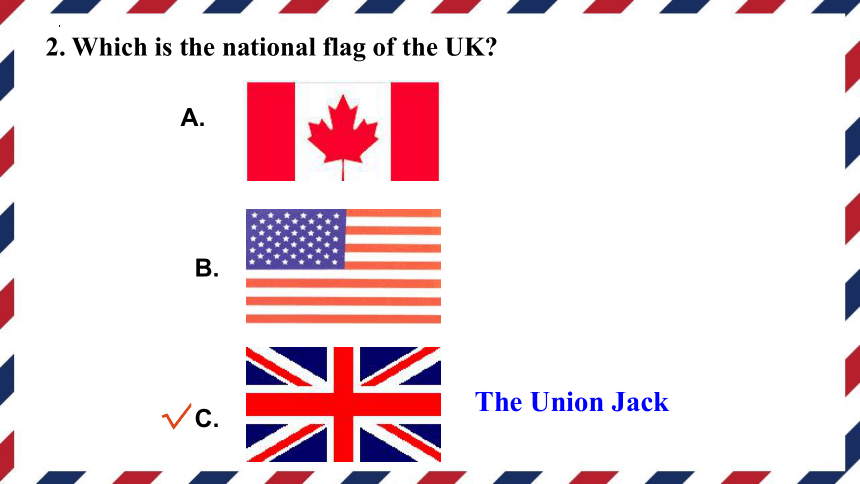
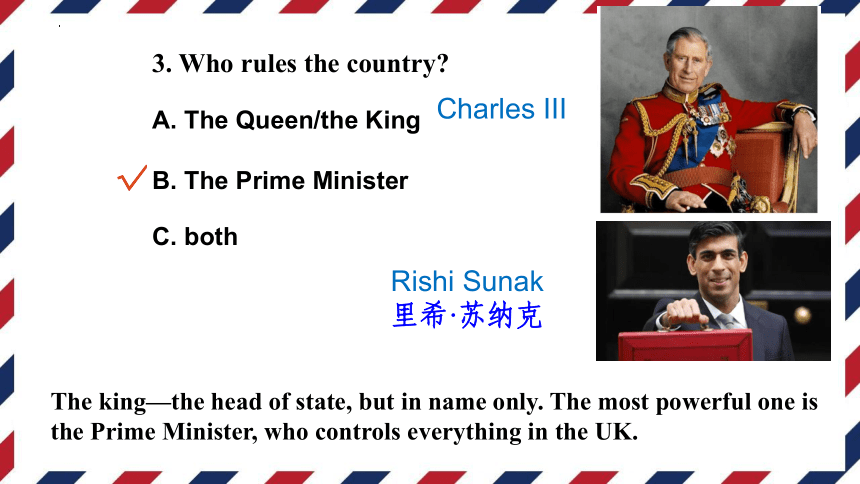
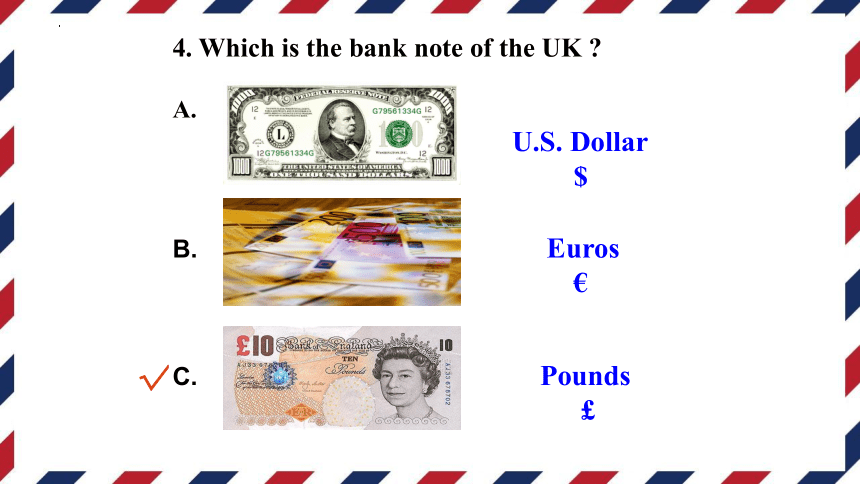
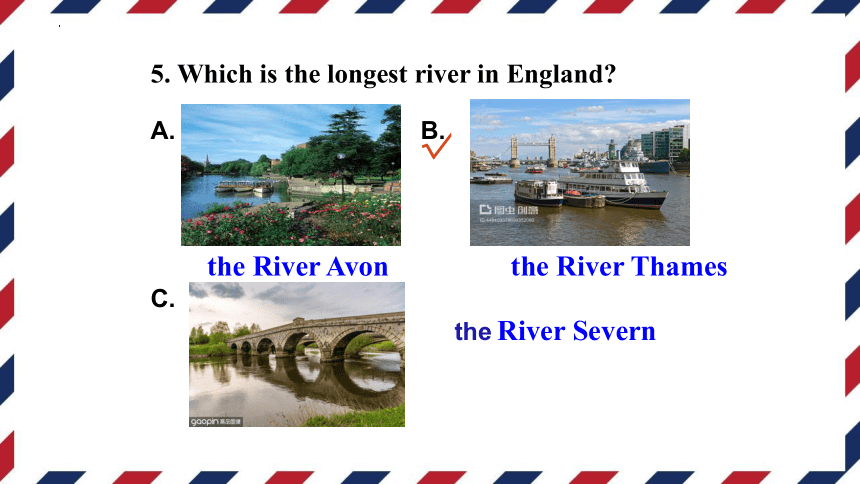
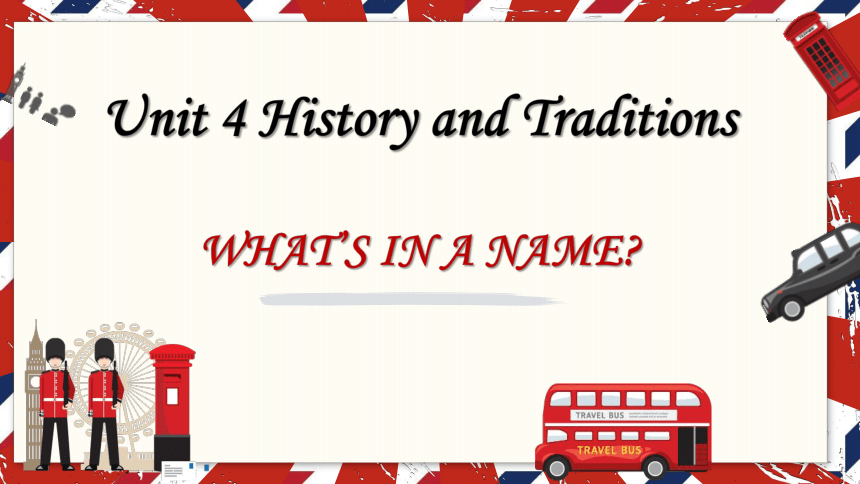

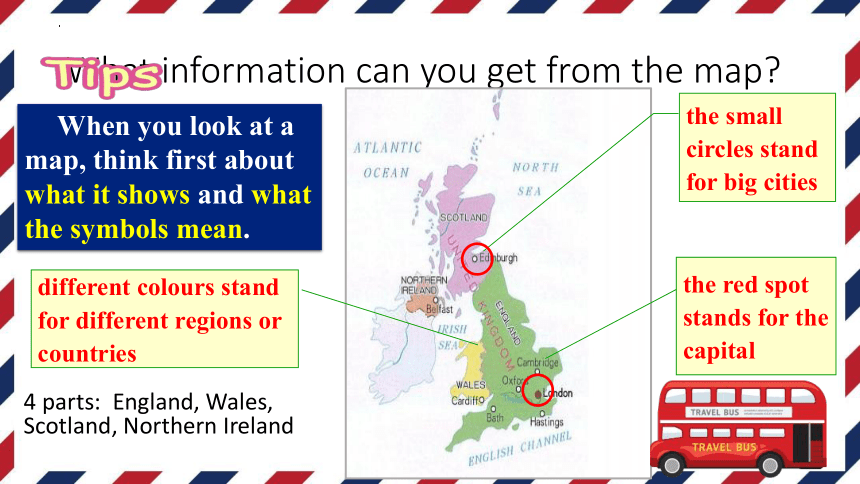
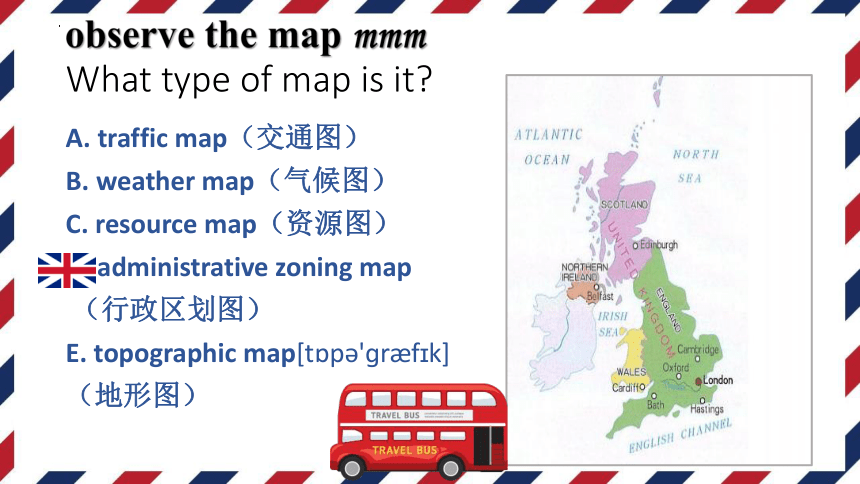
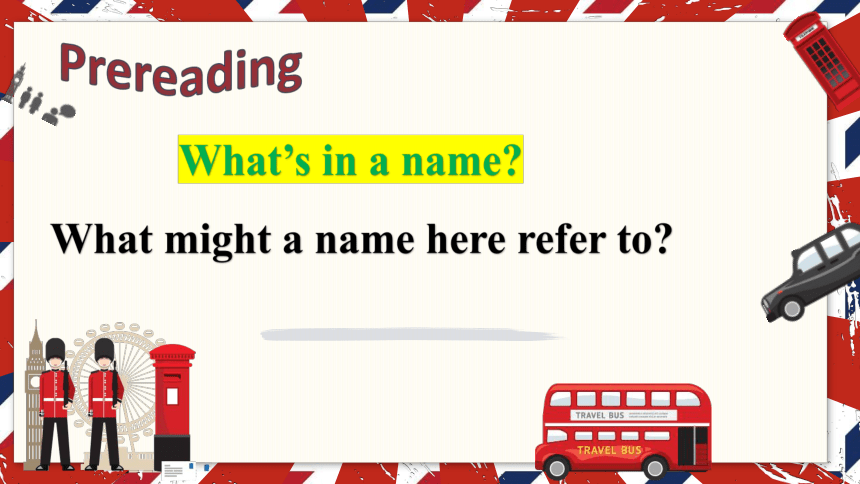
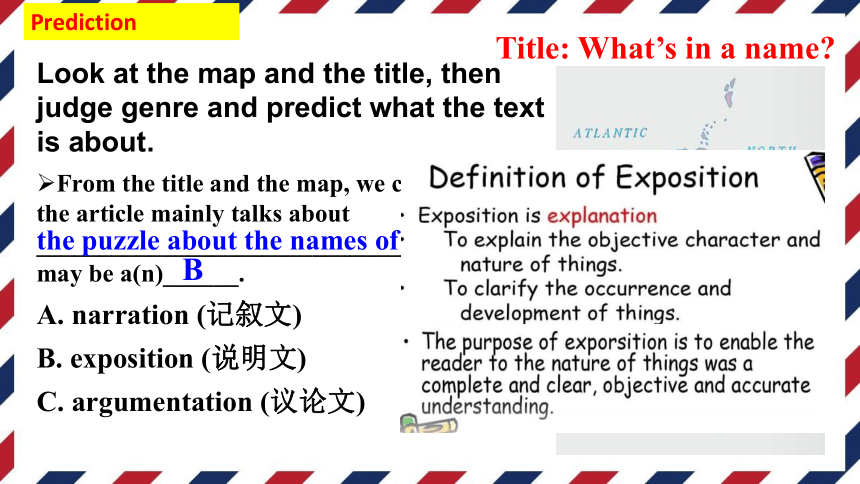
内容文字预览
(共31张PPT)
1. What are the provinces called in England
A. departments
B. states
C. counties
Let’s have a competition.
√
Lead-in
A.
B.
C.
The Union Jack
√
2. Which is the national flag of the UK
3. Who rules the country
A. The Queen/the King
B. The Prime Minister
C. both
Rishi Sunak
里希·苏纳克
The king—the head of state, but in name only. The most powerful one is the Prime Minister, who controls everything in the UK.
Charles III
√
4. Which is the bank note of the UK
A.
U.S. Dollar
$
B. Euros
?
C. Pounds
√
5. Which is the longest river in England
B.
the River Avon the River Thames
C.
the River Severn
√
Unit 4 History and Traditions
WHAT’S IN A NAME
TASK ONE
read the map
What information can you get from the map
4 parts: England, Wales, Scotland, Northern Ireland
the small circles stand for big cities
the red spot stands for the capital
different colours stand for different regions or countries
When you look at a map, think first about what it shows and what the symbols mean.
observe the map mmm
What type of map is it
A. traffic map(交通图)
B. weather map(气候图)
C. resource map(资源图)
D. administrative zoning map
(行政区划图)
E. topographic map[t p 'ɡr f k]
(地形图)
What’s in a name
Prereading
What might a name here refer to
Look at the map and the title, then judge genre and predict what the text is about.
From the title and the map, we can know that the article mainly talks about ___________________________________ , so it may be a(n)______.
A. narration (记叙文)
B. exposition (说明文)
C. argumentation (议论文)
Title: What’s in a name
the puzzle about the names of the UK
B
Prediction
Para. 1
Para. 2
Para. 3
Para. 4
Para. 5
A. The origin of the names of the UK.
B. The significance of studying the history of a country.
C. The similarities and differences of the four countries.
D. The introduction to the topic.
E. The four groups of people in the history of the UK and the changes they brought.
Skimming
Read the passage quickly, then match the paragraph
with its main idea.
How does the author introduce the topic
Question
Solution
----- by raising a puzzle to arouse(激起) interest of the readers
Detailed-reading(Para.1& Para.2)
. The introduction to the topic.
read par2 to solve
the puzzle
read para 2 to solve the puzzle
What the main idea of para 2?
The _______of the united kindom.
formation
How does the author describe its formation
by ______order.
16th century
18th century
19th century
20th century
the Kingdom
of England
the Kingdom
of Great Britain
the United
Kingdom of
Great Britain
and Ireland
the United
Kingdom of
Great Britain
and Northern
Ireland
the United
Kingdom
the UK
England
+Wales
England
+Wales
+Scotland
Great Britain
+Ireland
Great Britain
+Northern Ireland
the formation of the UK
Does the four countries work together in all areas
Read par3 to find out the differences and similarities
Similarities
Differences
flag
currency
military defence
education system
legal system
traditions
football teams
Detailed-reading(Para.3)
How does the author develop this paragraph
A , By expressing some personal opinions.
B , by using a couple of quotes
C, by referring to a social phenomenon.
D, by making some comparisons.
the history of the UK
Para 1 introduction
Para 2
the formation of the UK
Para 3
smilarities and differences
What are the advantages of studying the history of the UK
Read para 4 to find the advantages of studying the history of the UK.
Who left deep influence on the country and the its traditions
There were 4 groups of people once conquered the UK.
Do you know who are they
C. Anglo-Saxons
B. Romans
D. Normans
A. Vikings
the first group
the second group
the third group
the fourth group
Detailed-reading(Para.4)
towns and roads
language and houses
vocabulary and
names of locations
castles, legal system and French words
1st
8th
5th
11th
Romans came.
Anglo-Saxons arrived.
Vikings came.
Normans conquered England.
Read para 5 to expore more advantages of studying the history of the UK.
1 what’s the writter’s attitude towards studying the history
A netural B indifferent C favorable D doubtful
2 Who might be the target reader of this paasge
A teachers B students C tourists D guides
make your visit much more enjoyable
What’s the main idea of the passage
A The history of the United Kingdom.
B the geography of the United Kingdom.
C the politicals of the United Kingdom
D the climate of the United Kingdom
What’s the structure of the passage
Discuss the importance of learning the history and culture of a country.
TASK FOUR
Discuss
A people without the knowledge of their past history, origin and culture is like a tree without roots.
—Marcus Garvey
一个不了解自己历史、起源和文化的民族,就如同一棵无根之树。
Cultural Confidence
Is it necessary for visitors to study the history and culture of a country before visiting it Why
It will help us .
understand the place better and have a more enjoyable experience
communicate better with people about their history and cultures and have a richer experience
Discussion
Thank you !
1. What are the provinces called in England
A. departments
B. states
C. counties
Let’s have a competition.
√
Lead-in
A.
B.
C.
The Union Jack
√
2. Which is the national flag of the UK
3. Who rules the country
A. The Queen/the King
B. The Prime Minister
C. both
Rishi Sunak
里希·苏纳克
The king—the head of state, but in name only. The most powerful one is the Prime Minister, who controls everything in the UK.
Charles III
√
4. Which is the bank note of the UK
A.
U.S. Dollar
$
B. Euros
?
C. Pounds
√
5. Which is the longest river in England
B.
the River Avon the River Thames
C.
the River Severn
√
Unit 4 History and Traditions
WHAT’S IN A NAME
TASK ONE
read the map
What information can you get from the map
4 parts: England, Wales, Scotland, Northern Ireland
the small circles stand for big cities
the red spot stands for the capital
different colours stand for different regions or countries
When you look at a map, think first about what it shows and what the symbols mean.
observe the map mmm
What type of map is it
A. traffic map(交通图)
B. weather map(气候图)
C. resource map(资源图)
D. administrative zoning map
(行政区划图)
E. topographic map[t p 'ɡr f k]
(地形图)
What’s in a name
Prereading
What might a name here refer to
Look at the map and the title, then judge genre and predict what the text is about.
From the title and the map, we can know that the article mainly talks about ___________________________________ , so it may be a(n)______.
A. narration (记叙文)
B. exposition (说明文)
C. argumentation (议论文)
Title: What’s in a name
the puzzle about the names of the UK
B
Prediction
Para. 1
Para. 2
Para. 3
Para. 4
Para. 5
A. The origin of the names of the UK.
B. The significance of studying the history of a country.
C. The similarities and differences of the four countries.
D. The introduction to the topic.
E. The four groups of people in the history of the UK and the changes they brought.
Skimming
Read the passage quickly, then match the paragraph
with its main idea.
How does the author introduce the topic
Question
Solution
----- by raising a puzzle to arouse(激起) interest of the readers
Detailed-reading(Para.1& Para.2)
. The introduction to the topic.
read par2 to solve
the puzzle
read para 2 to solve the puzzle
What the main idea of para 2?
The _______of the united kindom.
formation
How does the author describe its formation
by ______order.
16th century
18th century
19th century
20th century
the Kingdom
of England
the Kingdom
of Great Britain
the United
Kingdom of
Great Britain
and Ireland
the United
Kingdom of
Great Britain
and Northern
Ireland
the United
Kingdom
the UK
England
+Wales
England
+Wales
+Scotland
Great Britain
+Ireland
Great Britain
+Northern Ireland
the formation of the UK
Does the four countries work together in all areas
Read par3 to find out the differences and similarities
Similarities
Differences
flag
currency
military defence
education system
legal system
traditions
football teams
Detailed-reading(Para.3)
How does the author develop this paragraph
A , By expressing some personal opinions.
B , by using a couple of quotes
C, by referring to a social phenomenon.
D, by making some comparisons.
the history of the UK
Para 1 introduction
Para 2
the formation of the UK
Para 3
smilarities and differences
What are the advantages of studying the history of the UK
Read para 4 to find the advantages of studying the history of the UK.
Who left deep influence on the country and the its traditions
There were 4 groups of people once conquered the UK.
Do you know who are they
C. Anglo-Saxons
B. Romans
D. Normans
A. Vikings
the first group
the second group
the third group
the fourth group
Detailed-reading(Para.4)
towns and roads
language and houses
vocabulary and
names of locations
castles, legal system and French words
1st
8th
5th
11th
Romans came.
Anglo-Saxons arrived.
Vikings came.
Normans conquered England.
Read para 5 to expore more advantages of studying the history of the UK.
1 what’s the writter’s attitude towards studying the history
A netural B indifferent C favorable D doubtful
2 Who might be the target reader of this paasge
A teachers B students C tourists D guides
make your visit much more enjoyable
What’s the main idea of the passage
A The history of the United Kingdom.
B the geography of the United Kingdom.
C the politicals of the United Kingdom
D the climate of the United Kingdom
What’s the structure of the passage
Discuss the importance of learning the history and culture of a country.
TASK FOUR
Discuss
A people without the knowledge of their past history, origin and culture is like a tree without roots.
—Marcus Garvey
一个不了解自己历史、起源和文化的民族,就如同一棵无根之树。
Cultural Confidence
Is it necessary for visitors to study the history and culture of a country before visiting it Why
It will help us .
understand the place better and have a more enjoyable experience
communicate better with people about their history and cultures and have a richer experience
Discussion
Thank you !
